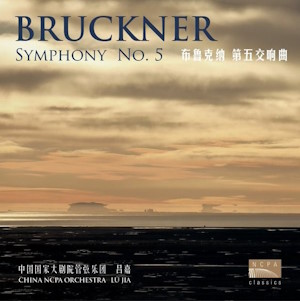
Anton Bruckner (1824-1896)
Symphony No. 5 in B-flat major, WAB 105 (ed. Nowak)
China NCPA Orchestra/Lü Jia
rec. live composite, 11-13 July 2024, China NCPA Concert Hall, Beijing
NCPA Classics 81620219-1 [2 CDs: 85]
At 24 minutes, the timing of the first movement of the Fifth Symphony here is the slowest in the catalogue, even more than Celibidache and very similar to Ballot’s. Overall, Celibidache and Ballot are still the slowest, with the former’s nine recordings timing at anything between 83 and 91 minutes and the latter at just under 89 minutes – in other words, Lü Jia has here daringly thrown in his lot with the slow-pokes and once again gone for the – cliché alert – “mighty cathedrals of sound” as he has throughout this series – and it works. Following the practice of several conductors I admire in this symphony, such as Shimono, Eichhorn, Klemperer, Karajan and his illustrious Japanese Brucknerian predecessor Takashi Asahina, Lü Jia keeps the finale broad at 25 minutes which creates a nice symmetry and is a wise choice, as that hybrid-form movement, with its three disparate themes and concluding, brief quasi-chorale, needs some propulsion to avoid any sense of fragmentation.
I have already remarked on this kinship in my previous review of the first six symphonies released from this source and everything I say there about the stately beauty of the orchestra playing and the atmosphere of concentrated dedication the conductor brings to playing Bruckner also applies here. Let me give an example: the sheer majestic weight at 3:15 in the Adagio when the second subject bursts forth; it is mightily impressive. I can understand that this approach might go down well as a one-off concert experience but some might not want to encounter it in repeated listening; Bruckner aficionados who like a “broad church” approach to interpretation will be tolerant of its expansiveness, even if others will baulk at it, especially as the recent trend is towards interpretations which are lighter on their feet.
The Scherzo is similarly hefty, with quite a thump on the downbeat but it certainly doesn’t drag and this in combination with the prominence of the percussion emphasises the menace and brutality of the two outer sections. The Trio, in contrast, is graceful and bucolic.
The finale opens at a stealthy pace and the gap before the interjections by the impudent solo clarinet is daringly prolonged. The music soon assumes a massive, emphatic character but the switch to the second subject at 3:11 is light, skipping and charming, then the descending octave figure really gathers momentum and the sheer drive and sonority of the orchestra before the grand, hieratic statement reminiscent of the Dresden Amen both really impress. There is a Bachian inexorability about the development of the second fugal subject; the brass are splendid – no blips or flubs. The intensity of the final five minutes is gripping. This is in many ways a match for Shimono’s epic account (review); it seems that they really know how to deliver Bruckner in Japan, but we may now say the same for China – and this is very much how I like to hear it.
As before, the sound is exemplary and there is virtually no extraneous noise, apart from the occasional subdued grunt from the conductor. On this evidence, Chinese audiences are evidently highly considerate and attentive, unlike some of the tubercular crowds I have on occasion encountered in London (although to be fair, the absolute, rapt silence I encountered in the final bars of Mahler’s Ninth Symphony in a recent concert conducted by Hebert Blomstedt in the Royal Festival Hall was exemplary).
Ralph Moore
Availability including complete set of nine symphonies: Sunrise Music


















